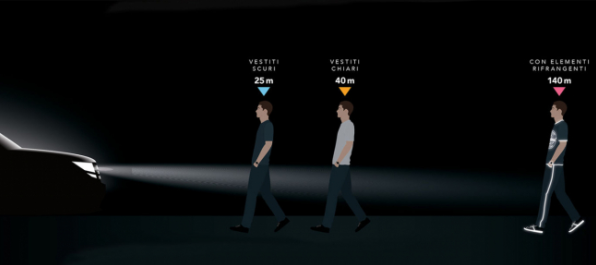In this period of the year, the hours of daylight are reduced, particularly in the morning and at dusk, considerably affecting the number of road accidents. In the last 10 years it has been noted that from November to February, from 05.00 to 09.00 and from 17.00 to 19.00, the probability of being injured or killed in accidents increases up to 58% compared to the rest of the year. This percentage is higher for less protected users, such as motorcyclists, cyclists, and pedestrians. The TCS, on the occasion of the international day of light, draws attention to this danger and to the need to see and be seen.
The TCS recommends that the most vulnerable road users pay particular attention to the visibility conditions, adopting a defensive guide and equipping themselves with clearly visible and season-appropriate safety clothing. The accidents that see them involved are more frequent in these months, characterized by reduced brightness and difficult atmospheric situations.
Motorcyclists, cyclists, and pedestrians at risk
For motorcyclists, the risk of accidents in the morning, from November to February, is almost 60% higher than in the other months of the year. This time slot, in addition to that between 17.00 and 19.00 (for a total of 6 hours), counts – over 24 hours – more than 40% of the motorists involved in an accident.
Even cyclists are equally exposed to these dangers in the same critical period of the year. A traditional cyclist is 52% more likely to incur an accident between 05.00 and 09.00 and even has an additional 54% chance that such an accident will cause serious injury or death. This last risk also affects drivers of electric bicycles with a percentage of 43% in the same time slot.
Pedestrians are the most vulnerable users in road traffic, particularly in winter. The greatest number of accidents happens in the morning with 44% more than 25% which is usually included at the end of the day.
Some tips to move safely
Road users are responsible for their vision and to be seen at all times. This golden rule is even more important for users who do not drive, so they are not protected by a body and are therefore more vulnerable in road traffic.
To be able to see well, in this period characterized by short days, cyclists and motorcyclists must check the lighting of their vehicle, before setting off. For their part, pedestrians must favor well-lit paths, to observe traffic well and prevent, where appropriate, dangers.
At the same time, it is advisable to increase one’s visibility. Drivers on two wheels can equip them with reflectors and wear light or reflective clothing with reflective tape. Clothing is an essential factor for safety, even for pedestrians. The “Made Visible” campaign, conducted by the TCS with the Road Safety Fund, provides numerous attractive solutions to combine fashion and visibility in all circumstances. Scarves, stickers, pendants, stylized backpacks: the possibilities to make oneself more visible are not lacking!
